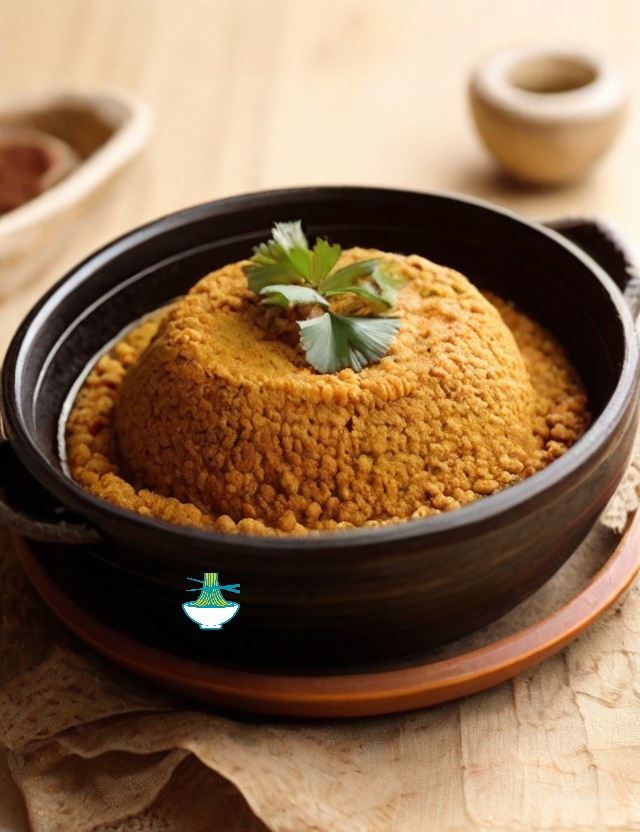Welcome to the heart of West Africa, where the vibrant culture of Burkina Faso meets the enticing world of Sagabo cuisine. In this culinary adventure, we explore the essence of Burkina Faso's gastronomy through the lens of a traditional Sagabo food recipe. Get ready to tantalize your taste buds with a symphony of flavors, as we unveil the secrets behind this beloved dish that reflects the warmth, community, and history of Burkina Faso. Join us as we embark on a flavorful journey, celebrating the unique blend of ingredients that make Sagabo a true culinary masterpiece.
Ingredients:
- 2 cups millet or sorghum flour
- 4 cups water
- 1 teaspoon salt
- Banana leaves or parchment paper (for wrapping)
Instructions:
Prepare the Millet or Sorghum Flour:
1-In a large mixing bowl, combine the millet or sorghum flour with water. Mix thoroughly to form a smooth, lump-free batter.
2-Allow the batter to rest for at least 2 hours. This helps to ferment and develop the flavors.
Seasoning:Add salt to the batter and mix well. Adjust the salt according to your taste preferences.
Cooking:
1-Preheat a steamer or a large pot with a steaming rack over medium heat.
2-If using a pot, add enough water to the bottom without touching the steaming rack.
3-While the steamer is heating, prepare the wrapping materials. Cut banana leaves into square pieces or use parchment paper.
Assembling the Sagabo:
1-Place a spoonful of the batter onto the center of each piece of banana leaf or parchment paper.
2-Fold the sides and ends of the leaves or paper over the batter, creating a neat parcel. Secure with toothpicks if necessary.
Steaming:
1-Arrange the wrapped Sagabo parcels in the steamer or on the steaming rack.
2-Steam for about 30-40 minutes or until the Sagabo is firm and cooked through.
Serve:
1-Allow the Sagabo to cool for a few minutes before unwrapping.
2-Serve warm and enjoy the unique flavors of Burkina Faso Sagabo.
This traditional Sagabo dish made with millet or sorghum flour captures the essence of Burkina Faso's culinary heritage. Whether shared with friends or enjoyed as a family meal, Sagabo brings a taste of West Africa to your table, celebrating the rich cultural tapestry of Burkina Faso.

Nutritional Values:
The nutritional values for the ingredients listed in the Burkina Faso Sagabo recipe can vary based on specific brands and varieties. However, here are approximate values:
2 cups Millet or Sorghum Flour:
- Calories: 1,200 kcal
- Protein: 20g
- Carbohydrates: 240g
- Fiber: 20g
- Fat: 8g
Benefits: Rich in essential nutrients such as magnesium, phosphorus, and fiber. Millet and sorghum are gluten-free grains that provide sustained energy, support digestion, and contribute to overall heart health.
4 cups Water:
- Water does not contribute significant calories or macronutrients. It is essential for hydration and helps in the preparation of the dish.
Benefits: Essential for hydration and overall bodily functions. Water supports digestion, nutrient absorption, and helps maintain body temperature. Adequate water intake is crucial for overall health and well-being.
1 teaspoon Salt:
- Sodium content: Approximately 2,300 mg (Note: This is a rough estimate, and actual sodium content can vary based on the type and brand of salt used.)
Benefits: While salt (sodium) is necessary for various bodily functions, including maintaining proper fluid balance and nerve function, it should be consumed in moderation. The small amount used in this recipe adds flavor to the dish. However, excessive salt intake can contribute to health issues, so it's important to be mindful of overall sodium consumption.
Banana leaves or Parchment Paper (for wrapping):
- These do not contribute significant nutritional content as they are primarily used as a wrapping material.
Benefits: Banana leaves add a unique flavor and aroma to the dish when used as wrapping material. They are also environmentally friendly and can enhance the overall presentation. Parchment paper serves as a convenient and non-stick option for wrapping the Sagabo parcels, ensuring the dish is cooked evenly.
It's important to note that the nutritional values provided are general estimates and can vary based on the specific products used. Additionally, the cooking method and any additional ingredients or variations may impact the overall nutritional profile of the final dish. If you have specific dietary concerns or are following a particular nutritional plan, consider consulting with a nutritionist or using a nutritional calculator for more precise information.


Comments